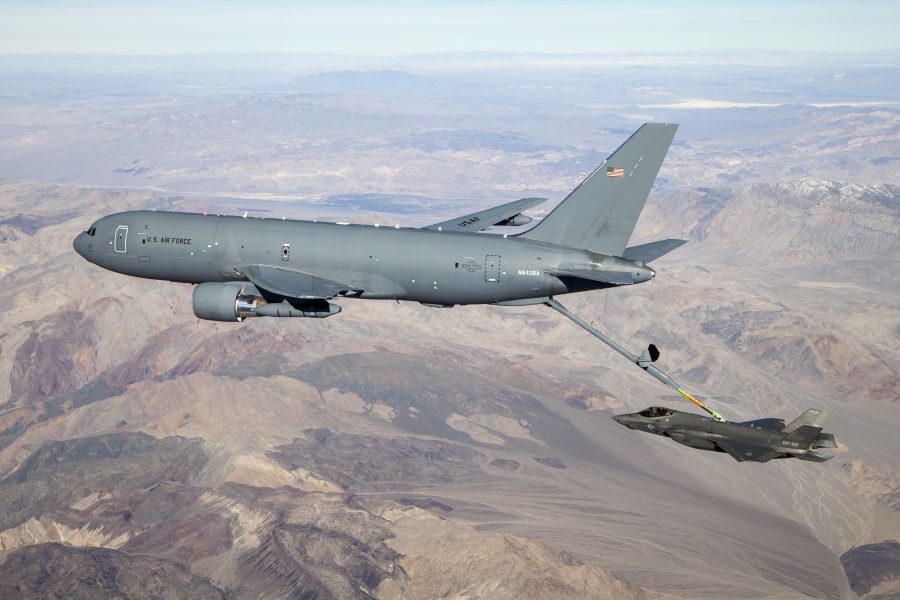F-35 and F-22 jets, fighting off sophisticated military forces in a dangerous area without communications, briefly divert to fill up on gas. A KC-46 tanker plane hovers just outside the high-threat zone with fuel, as well as a new pod under its wing that shares mission orders created by artificial intelligence algorithms crunching big data.
That pod is slated to be the first capability deployed under the Air Force’s Advanced Battle Management System concept, possible next year using technologies demonstrated in the series of combat experiments known as “on-ramps,” according to the Air Force’s top weapons buyer and the head of Air Mobility Command.
ABMS, which last month became a venture of the Air Force’s secretive Rapid Capabilities Office, needs to move beyond research and development into procurement and operations, said Will Roper, assistant secretary of the Air Force for acquisition, technology, and logistics. This tanker solution will be the first step.
“As a formal program, with a baseline and schedule, you’ll be able to see a mini-internet instantiated in our mobility fleet, our tankers, that’s connected back to the cloud and analytics and AI that are pushing forward suggested courses of action,” Roper said.
He envisions the pod, which could also ride on KC-135s, will be able to provide combat options that AI has created specifically for each mission.
Those tankers can then relay information over local data gateways “that are doing the ‘Babel Fish’ translation to F-35s and F-22s that may be too far into the [anti-access, area-denial] bubble,” Roper said in an interview, referencing the language-translating fish in the novel “The Hitchhiker’s Guide to the Galaxy.” “That will be a mini-snapshot of the bigger internet we hope to build across the joint force.”
ABMS, which ramped up from replacing the E-8C Joint Surveillance Target Attack Radar System planes, has ballooned into an “Internet of Military Things” that aims to connect sensors and shooters across the joint force via cloud-based networks and revolutionize how the Air Force operates. Critics, including some in Congress, argue the program is growing without a clear direction.
Roper said the tanker solution, part of a capability called Release No. 1, will be a tangible example to prove the Air Force has been doing “the digital grunt work of building that infrastructure, so that we could ultimately get to the cool stuff like machine-to-machine data exchanges and AI on the battlefield.”
The components of the new system have been demonstrated and proven through the ABMS demos, and the Air Force is reviewing the program. The RCO is looking at “different podded form factors and the right way to acquire them and sustain them, ensuring that they connect back to our multi-classification cloud,” Roper said.
“It’s just acquisition work. It’s time for ABMS to start having procurement and operations and sustainment funding associated with it,” he said.
He did not say which companies could be involved in producing the pod.
For Air Mobility Command, the new pod will be the result of years of work to grow tanker participation in combat. While fighters and bombers need gas to fight, KC-46s and KC-135s can also serve in an important command-and-control role.
“We have an opportunity with our tankers who will be airborne, where our mission is to support the tactical forces,” AMC boss Gen. Jacqueline D. Van Ovost said in an interview. “Why not have the capability to relay … line-of-sight and beyond-line-of-sight links to ensure that our tactical forces have the intelligence and support that they need while they’re airborne?”
Capabilities like this don’t have to be “fancy things,” she said.
“I’m looking at things that can slap on and transmit,” she said. “It may be a podded solution that could do just about anything, so that I won’t have to modify every airplane. Every airplane accepts a pod. … Then we just place the pods in areas of the world where we might need them, and make it simple for the crews to operate.”
While fighter jets and other platforms have also tested promising new networking technologies, Roper told Air Force Magazine that tankers will cross the finish line first.
“We haven’t discussed any candidates other than mobility as the first place we target,” he said.
Editor’s note: This story was updated at 9:43 a.m. Dec. 20 to reflect additional information about the release of the capability.

